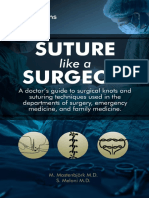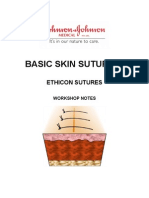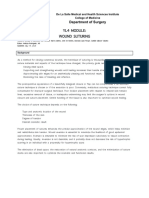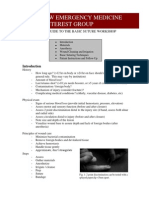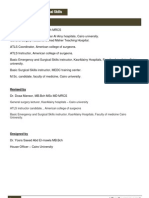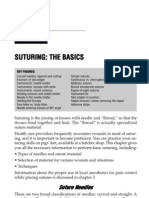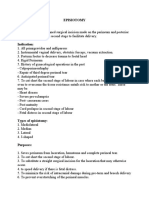Dermnet NZ: Suturing Techniques
Dermnet NZ: Suturing Techniques
Uploaded by
Tamjid KhanCopyright:
Available Formats
Dermnet NZ: Suturing Techniques
Dermnet NZ: Suturing Techniques
Uploaded by
Tamjid KhanOriginal Description:
Original Title
Copyright
Available Formats
Share this document
Did you find this document useful?
Is this content inappropriate?
Copyright:
Available Formats
Dermnet NZ: Suturing Techniques
Dermnet NZ: Suturing Techniques
Uploaded by
Tamjid KhanCopyright:
Available Formats
Suturing techniques.
DermNet NZ
17/05/08 10:20 PM
DermNet NZ
Authoritative facts about the skin from the New Zealand Dermatological Society Incorporated.
Home | Procedures | Suturing techniques: PDF 100 KB
Suturing techniques
Aim
To demonstrate the basic principles of suturing for the closure of cutaneous surgical wounds.
The tools
To obtain the best results, it is important to have good quality instruments that are the correct size for the location and nature of the wounds being closed. The instruments also need to be correctly sterilised and handled carefully. The basic suturing kit includes: needle holder fine suture scissors toothed tissue forceps +/- skin hook appropriate suture material
Suture material
The two biggest considerations when choosing a suture are the location and tension of the wound. Other important considerations are tensile strength, knot strength, handling, and tissue reactivity. Sutures are divided into two major groups: Absorbable lose the majority of their tensile strength in less than 60 days. They are generally used for buried sutures and do not require removal. Non-absorbable maintain the majority of their tensile strength for more than 60 days. They are generally used for skin surface sutures and do require removal postoperatively. Suture needles also come in a variety of shapes and sizes. Curved needles are almost exclusively used in dermatological surgery. Cutting needles move through the tissue more easily and may have their primary cutting edge on the inside of the curve (conventional cutting) or outside of the curve (reverse cutting). The benefit of reverse cutting is that the tapered puncture left by the suture is directed away from the wound edge and therefore tissue tearing is less common. Non-cutting round needles cause even less tissue tearing and may be especially useful in delicate areas and fascia.
Technique
Grip The needle holder should be held with the palm grip as illustrated in Figure 1. This allows superior wrist mobility than if the fingers are placed in the handle loops. The needle should be grasped between 1/3 to 1/2 of the distance between the suture attachment and the needle tip. Suturing techniques: grip
http://www.dermnetnz.org/procedures/suturing.html
Page 1 of 5
Suturing techniques. DermNet NZ
17/05/08 10:20 PM
Figure 1
Knot tying (Square knot) The long end of the suture is wrapped around the tip of the closed needle holder twice before grasping the short end of the suture with the needle holder. The first double knot is then pulled gently tight. Two (or three) further single throws are then added in a similar fashion to secure the knot. Each throw is pulled in the opposite direction across the wound edge. See Figure 2 Suturing techniques: square knot
Figure 2
Simple interrupted suture The wound edge should be gently stabilised with either toothed forceps or a skin hook. The needle should enter perpendicular to the skin 3-5mm from the wound edge. See Figure 3. Entering perpendicular causes a wider bite of deeper tissue to be included in the suture than at the surface and consequently causes more wound edge eversion and ultimately a superior cosmetic result with a thinner scar. A common mistake is to enter the skin at a flatter angle resulting in much less wound edge eversion as shown in Figure 4. The knot is then tied as seen in Figure 2. Suturing techniques: simple interrupted suture
Figure 3
Figure 4
Continuous suture Using a continuous suture rather than multiple interrupted sutures offers a significant time saving. However,it is not as strong as interrupted sutures, and can strangulate the blood supply in wounds under more than minimal tension. An interrupted suture is performed, but only the free suture end is cut before the needle is
http://www.dermnetnz.org/procedures/suturing.html Page 2 of 5
Suturing techniques. DermNet NZ
17/05/08 10:20 PM
tension. An interrupted suture is performed, but only the free suture end is cut before the needle is reintroduced and directed diagonally across the wound to exit the skin on the other side. The suture is then brought across perpendicular to the wound edge and reintroduced on the first side again with each bite. See Figure 5. Once the entire wound is closed, a loop is made with the last pass of suture, and this loop is grasp by the needle holder to tie the knot. This is demonstrated in figure 6. Suturing techniques: continuous suture
Figure 5
Figure 6
Vertical mattress suture This suture provides excellent wound support, decreases dead space, and provides superior wound edge eversion. The needle is introduced 5-10mm from the wound edge and a deep bite of tissue is taken before exiting the skin in the same position on the opposite wound edge. The needle position is then reversed in the needle holder, and the needle is reintroduced 1-3mm from the second side of the wound and a smaller bite of tissue is taken before exiting on the first side of the wound. A knot can then be secured as shown in Figure 7. Suturing techniques: vertical mattress suture
Figure 7
Horizontal mattress suture This suture is especially good for distributing wound tension across larger wounds particularly for the initial sutures. The needle is introduced 5-10mm from the wound edge and exited on the opposite side of the wound. The needle is then reintroduced on the second side of the wound but 3-5mm along the wound edge from the exit point. The suture exits in the same position on the first side of the wound and the suture is tied as shown in Figure 8. The disadvantage of this suture is the risk of strangulation of the dermal blood supply and subsequent edge necrosis. Suturing techniques: horizontal mattress suture
http://www.dermnetnz.org/procedures/suturing.html
Page 3 of 5
Suturing techniques. DermNet NZ
17/05/08 10:20 PM
Figure 8
Running subcuticular suture The benefit of this suture is the minimal epidermal puncture points allowing the suture to be left in place longer without suture-track scarring. The needle is introduced 10mm distal to one wound end and brought out inside the apex of the wound within the dermis. The free end of suture can be tied off on itself, or secured with a bead or crimp. Horizontal bites of dermis are then taken from alternating sides of the wound working towards the other wound apex. The second epidermal puncture is made when the needle exits 10mm from the other end of the wound. See figure 9. The second free end can be secured in the same way as the first. Alternatively, absorbable suture material can be used and the ends tied off underneath the skin surface. Suturing techniques: running subcuticular suture
Figure 9
Buried suture This suture is extremely important for distributing wound tension to the dermis rather than the epidermis and also for closing dead space. It provides longer-term support to the healing wound and improves the cosmetic result. The wound edge is everted with a skin hook and then an absorbable suture is introduced at the subcutaneous level and brought back out at dermal level on the same side of the wound. See figure 10. The needle then enters the same dermal level on the opposite side of the wound and exits the in the same subcutaneous level as it was initially entered into on the first side of the wound. The knot is tied deep at the subcutaneous level and the free ends cut short. See figure 11. Suturing techniques: buried suture
Figure 10
Figure 11
http://www.dermnetnz.org/procedures/suturing.html
Page 4 of 5
Suturing techniques. DermNet NZ
17/05/08 10:20 PM
Suture removal
The time to suture removal depends on the location and the degree of tension the wound was closed under. This varies between surgeon and situation, but as a general rule sutures on the head and neck are usually removed between five and seven days post-operatively, while sutures on trunk or extremity wounds are typically removed between ten and fourteen days. To remove sutures, one tail of the suture should be grasp with forceps and pulled gently towards one side to the wound, elevating the knot. The opposite side of the suture should then be cut with stitch-cutters or fine suture scissors immediately under the knot. See Figure 12. The suture can then be pulled out of the tissue by pulling towards the opposite side of the wound as seen in Figure 13. Suture removal
Figure 12
Figure 13
Draft 16 May 2008
Related information References: Surgery of the skin procedural dermatology. Ed Robinson JK, Hanke CW, Sengelmann RD, Siegel DM. Elsevier Mosby 2005. On DermNet NZ: Skin surgery Excision of skin lesions Skin biopsy Other websites: Books about skin diseases: See the DermNet NZ bookstore Author :Dr Todd Gunson, Dermatology Registrar, Greenlane Clinical Centre, Auckland, NZ
DermNet does not provide an on-line consultation service. If you have any concerns with your skin or its treatment, see a dermatologist for advice.
Created 2008. Last updated 17 May 2008. 2008 NZDS. Disclaimer.
http://www.dermnetnz.org/procedures/suturing.html
Page 5 of 5
You might also like
- Suture Like A Surgeon 1st EditionDocument116 pagesSuture Like A Surgeon 1st EditionMithilesh Reddy100% (11)
- Anatomy Reda Notes PDFDocument197 pagesAnatomy Reda Notes PDFTamjid Khan100% (2)
- Menagerie: Teeny TinyDocument124 pagesMenagerie: Teeny TinyLeila Azevedo100% (16)
- Arterial Blood Gases Made Easy PDFDocument66 pagesArterial Blood Gases Made Easy PDFTamjid Khan100% (5)
- B D Chaurasia's Handbook of General Anatomy (4th Ed)Document276 pagesB D Chaurasia's Handbook of General Anatomy (4th Ed)iahmed300090% (83)
- Suturing TechniquesDocument7 pagesSuturing TechniquesFiona LeeNo ratings yet
- 32 - Suturing TechniqueDocument17 pages32 - Suturing TechniqueAna ambiyaNo ratings yet
- SUTURINGDocument6 pagesSUTURINGSahin mollickNo ratings yet
- Basic Surgical TechniqueDocument7 pagesBasic Surgical TechniqueAhmed Reda DoniaNo ratings yet
- SuturesDocument5 pagesSuturesTaiseer AtefNo ratings yet
- Suturing TechniquesDocument5 pagesSuturing TechniquesAndikaPurbaNo ratings yet
- Basic Skin SuturingDocument11 pagesBasic Skin SuturingSamer FarhanNo ratings yet
- Yl4 Module: Wound Suturing: Department of SurgeryDocument6 pagesYl4 Module: Wound Suturing: Department of SurgeryNehemiah FranciscoNo ratings yet
- Suturing TechniquesDocument32 pagesSuturing TechniquesRez QNo ratings yet
- Interrupted Sutures: Suturing Techniques Simple SuturesDocument5 pagesInterrupted Sutures: Suturing Techniques Simple SuturesMuhammad Ichsan MustariNo ratings yet
- Our Experience of Treatment of Large Skin Wounds With Excessively Tense MarginsDocument7 pagesOur Experience of Treatment of Large Skin Wounds With Excessively Tense MarginsAPTOSNo ratings yet
- Teknik SuturingDocument38 pagesTeknik SuturingrakaNo ratings yet
- Flora Belle ADocument4 pagesFlora Belle AmmmgmgmNo ratings yet
- EMIG Suture HandoutDocument10 pagesEMIG Suture HandoutEric GibsonNo ratings yet
- Basic Plastic Surgery Techniques and Principles: How To SutureDocument3 pagesBasic Plastic Surgery Techniques and Principles: How To SutureDarryl BettsNo ratings yet
- Suture Practice Kit Ebook PDFDocument18 pagesSuture Practice Kit Ebook PDFKarla Aguilar GuerreroNo ratings yet
- Suture RemovalDocument10 pagesSuture RemovalAndreea Teodora ConstantinNo ratings yet
- Mattress SuturesDocument2 pagesMattress SuturesIo DobriNo ratings yet
- Tilleman 2004Document7 pagesTilleman 2004이호원No ratings yet
- MergedDocument12 pagesMergedصقر قريشNo ratings yet
- Fingertip and Nail Bed InjuriesDocument27 pagesFingertip and Nail Bed Injuriesiwanbaong100% (1)
- Types of SuturingDocument18 pagesTypes of SuturingJayr ValmoresNo ratings yet
- Incision and DrainageDocument35 pagesIncision and DrainageVilma Delos Reyes100% (1)
- Surgical Skill - 240130 - 162547Document37 pagesSurgical Skill - 240130 - 162547Taseen KhanNo ratings yet
- Principles of SurgeryDocument10 pagesPrinciples of SurgeryCassie FramstadNo ratings yet
- Surgical SkillsDocument47 pagesSurgical SkillsSamah SuhailNo ratings yet
- SuturesDocument30 pagesSuturesBianca Corina MusatNo ratings yet
- Prospective Randomised Trial Comparing Traditional Suture Technique With The Dynamic Sliding Loop Suture Technique in The Closure of Skin LacerationsDocument4 pagesProspective Randomised Trial Comparing Traditional Suture Technique With The Dynamic Sliding Loop Suture Technique in The Closure of Skin LacerationsEdogawa RakhmanNo ratings yet
- Suturing TechniquesDocument5 pagesSuturing Techniqueshala sadeddinNo ratings yet
- SuturesDocument20 pagesSutureskirank_11No ratings yet
- Instrumentos, Sutura Materiales y Cierre OpcionesDocument13 pagesInstrumentos, Sutura Materiales y Cierre OpcionesJuan FagundezNo ratings yet
- Section Iic Suturing Techniques 2015Document13 pagesSection Iic Suturing Techniques 2015André Pinheiro de AraújoNo ratings yet
- Running SuturesDocument3 pagesRunning SuturesIo DobriNo ratings yet
- Acne Scar SubsisionDocument2 pagesAcne Scar SubsisionDiana Muchsin UnnangNo ratings yet
- Surgical Suture Materials Are Used in The Closure of Most Wound Types. The Ideal SutureDocument9 pagesSurgical Suture Materials Are Used in The Closure of Most Wound Types. The Ideal SutureToria053No ratings yet
- SutureDocument4 pagesSutureDanica DeeNo ratings yet
- Che 241 Clinical Skils IiDocument46 pagesChe 241 Clinical Skils Iiabubakarahama449No ratings yet
- Relevance of The Topic:: Guidelines Subject: DESMURGYDocument26 pagesRelevance of The Topic:: Guidelines Subject: DESMURGYRockybhaiNo ratings yet
- Incision Designs & Suturing Technique in Oral Surgery-Part-2Document16 pagesIncision Designs & Suturing Technique in Oral Surgery-Part-2Abeer Talal AL-hamarneh50% (2)
- GRV Sutures & Suturing Techniques - 035041Document66 pagesGRV Sutures & Suturing Techniques - 035041Priya sharmaNo ratings yet
- Fila Na AssgDocument14 pagesFila Na AssgFilimon ChenekeNo ratings yet
- Dressing and Bandages Lecture by Claudia Gherman, Răzvan CiocanDocument12 pagesDressing and Bandages Lecture by Claudia Gherman, Răzvan Ciocanglee.jumangit08No ratings yet
- Eye Surgery in Hot Climates 02Document25 pagesEye Surgery in Hot Climates 02Aulia CandraNo ratings yet
- 1394439331.2339suture and Suture Techniques For 3rdDocument26 pages1394439331.2339suture and Suture Techniques For 3rdMahnoor AnsariNo ratings yet
- Che 241 Clinical Skils IiDocument57 pagesChe 241 Clinical Skils Iiaoyishoma141No ratings yet
- Annsurg00349 0029Document5 pagesAnnsurg00349 0029aufar isytaharNo ratings yet
- Suturing - OxfordDocument12 pagesSuturing - OxfordGhada Al-OgailyNo ratings yet
- Oral Surgery, Sheet9, DR - SukaynaDocument11 pagesOral Surgery, Sheet9, DR - SukaynamzusaqNo ratings yet
- Skin GraftDocument7 pagesSkin GraftrchNo ratings yet
- Suture PrincipleDocument45 pagesSuture PrincipleislamellabbanNo ratings yet
- Facial Wound Assessment KitDocument9 pagesFacial Wound Assessment KitIJAR JOURNALNo ratings yet
- Advanced SuturingDocument18 pagesAdvanced SuturingAriyanie NurtaniaNo ratings yet
- Basic and Special Suturing Techniques in SurgeryDocument32 pagesBasic and Special Suturing Techniques in SurgeryRobins DhakalNo ratings yet
- Tie-Over Bandage-It's A Stretch!Document4 pagesTie-Over Bandage-It's A Stretch!NiñoTorresNo ratings yet
- A New Simple Technique For Making Facial DimplesDocument4 pagesA New Simple Technique For Making Facial DimplesdoctorbanNo ratings yet
- Easy Masks To Sew: Sizes and Styles to Make for Kids and AdultsFrom EverandEasy Masks To Sew: Sizes and Styles to Make for Kids and AdultsNo ratings yet
- Instructions To CandidateDocument3 pagesInstructions To CandidateTamjid KhanNo ratings yet
- Varicose Vein Exam SDocument5 pagesVaricose Vein Exam STamjid KhanNo ratings yet
- Surgical CompetenceDocument147 pagesSurgical CompetenceTamjid KhanNo ratings yet
- Essentials of Thoracic ImagingDocument158 pagesEssentials of Thoracic ImagingMohammed NoemanNo ratings yet
- ArmDocument57 pagesArmTamjid KhanNo ratings yet
- Adominal TBDocument50 pagesAdominal TBTamjid KhanNo ratings yet
- Https Upload - Wikimedia.org Wikipedia Commons e E6 Gray506Document1 pageHttps Upload - Wikimedia.org Wikipedia Commons e E6 Gray506Tamjid KhanNo ratings yet
- BooksDocument1 pageBooksTamjid KhanNo ratings yet
- Barr Body and HermaphroditismDocument41 pagesBarr Body and HermaphroditismTamjid KhanNo ratings yet
- Core Module 7: Surgical Procedures: Learning OutcomesDocument6 pagesCore Module 7: Surgical Procedures: Learning OutcomesTamjid KhanNo ratings yet
- Surgical Anatomy and Approaches 2014Document1 pageSurgical Anatomy and Approaches 2014Tamjid KhanNo ratings yet
- Surgical PhsyiologyDocument170 pagesSurgical PhsyiologyTamjid Khan100% (3)
- Cardiothoracic Critical CareDocument469 pagesCardiothoracic Critical CareTamjid Khan100% (4)
- The Process of Pinioning Involves The Cutting of One Wing at The Carpel JointDocument23 pagesThe Process of Pinioning Involves The Cutting of One Wing at The Carpel JointNanda FinisaNo ratings yet
- Sako Transcription Case1 r3 Operative ReportDocument3 pagesSako Transcription Case1 r3 Operative Report9ymmdqqyscNo ratings yet
- Jacobean Crewe Lwo 00 PeneDocument50 pagesJacobean Crewe Lwo 00 PeneAndrew Olsen100% (9)
- Mon Doll Tipo Green Frog-compressedDocument17 pagesMon Doll Tipo Green Frog-compressedAngelica searchNo ratings yet
- DamlaDocument27 pagesDamlawidda.tn04100% (1)
- Section 4. Repairs To Fabric CoveringDocument4 pagesSection 4. Repairs To Fabric CoveringrobinyNo ratings yet
- Medical Students Training Program - Square Knot - Penn SurgeryDocument5 pagesMedical Students Training Program - Square Knot - Penn SurgeryColin ClearyNo ratings yet
- Encyclopedia of Needlework (Ill - Therese de DillmontDocument2,261 pagesEncyclopedia of Needlework (Ill - Therese de DillmontAmber McDonald91% (23)
- Suture Materials and SuturingDocument65 pagesSuture Materials and SuturingRicha Bhosale100% (4)
- Ebooks File Textbook of Oral and Maxillofacial Surgery 4th Edition Neelima Anil Malik All ChaptersDocument62 pagesEbooks File Textbook of Oral and Maxillofacial Surgery 4th Edition Neelima Anil Malik All Chapterssewimrowa100% (4)
- 1230 Sun Sandow Advances in Tendon Repair Techniques and Implications For Postoperative ManagementDocument11 pages1230 Sun Sandow Advances in Tendon Repair Techniques and Implications For Postoperative ManagementanzzunNo ratings yet
- MR Bean TeddyDocument2 pagesMR Bean TeddyAley CNo ratings yet
- 55 Christmas Balls To Knit ExcerptDocument18 pages55 Christmas Balls To Knit Excerptsora kim67% (3)
- SurgicalDocument105 pagesSurgicalPAKEMPLOYEESNo ratings yet
- Pediatric Endourology TechniquesDocument125 pagesPediatric Endourology TechniquesArtiom MinzateanNo ratings yet
- Jcpe 12960Document9 pagesJcpe 12960Kyoko CPNo ratings yet
- Allopathy Medicine List of Pharamcy 6Document53 pagesAllopathy Medicine List of Pharamcy 6Rudresha.PNo ratings yet
- Surgical Instruments MBBSDocument68 pagesSurgical Instruments MBBSSaranya chandranNo ratings yet
- ScalpelDocument2 pagesScalpeljoy talosigNo ratings yet
- Basic Suturing Skills Booklet+Document34 pagesBasic Suturing Skills Booklet+Rohit Agrawal100% (3)
- Aios Glaucoma SXDocument79 pagesAios Glaucoma SXsubahNo ratings yet
- Protocol - V. Surgery 411Document16 pagesProtocol - V. Surgery 411maun04No ratings yet
- Handicraft7 8 Q2 W1 (L1 2)Document18 pagesHandicraft7 8 Q2 W1 (L1 2)Rochelle CatanNo ratings yet
- Natali Niv JasmineDocument41 pagesNatali Niv Jasmineremziamina100% (4)
- Needle HoldersDocument7 pagesNeedle HoldersBilal AnwarNo ratings yet
- Episiotomy DefinitionDocument4 pagesEpisiotomy Definitionnursing school0% (1)
- Operating Theatre Nursing and AnaesthesiaDocument6 pagesOperating Theatre Nursing and AnaesthesiaEden NamwabaNo ratings yet
- SopDocument18 pagesSopNitta MallikNo ratings yet
- 3b.inspection Procedures in SEWING ROOMDocument26 pages3b.inspection Procedures in SEWING ROOMAlokKumarNo ratings yet
